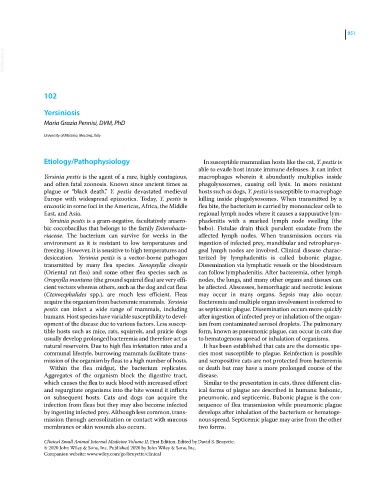Page 1013 - Clinical Small Animal Internal Medicine
P. 1013
951
VetBooks.ir
102
Yersiniosis
Maria Grazia Pennisi, DVM, PhD
University of Messina, Messina, Italy
Etiology/Pathophysiology In susceptible mammalian hosts like the cat, Y. pestis is
able to evade host innate immune defenses. It can infect
Yersinia pestis is the agent of a rare, highly contagious, macrophages wherein it abundantly multiplies inside
and often fatal zoonosis. Known since ancient times as phagolysosomes, causing cell lysis. In more resistant
plague or “black death,” Y. pestis devastated medieval hosts such as dogs, Y. pestis is susceptible to macrophage
Europe with widespread epizootics. Today, Y. pestis is killing inside phagolysosomes. When transmitted by a
enzootic in some foci in the Americas, Africa, the Middle flea bite, the bacterium is carried by mononuclear cells to
East, and Asia. regional lymph nodes where it causes a suppurative lym
Yersinia pestis is a gram‐negative, facultatively anaero phadenitis with a marked lymph node swelling (the
bic coccobacillus that belongs to the family Enterobacte bubo). Fistulae drain thick purulent exudate from the
riaceae. The bacterium can survive for weeks in the affected lymph nodes. When transmission occurs via
environment as it is resistant to low temperatures and ingestion of infected prey, mandibular and retropharyn
freezing. However, it is sensitive to high temperatures and geal lymph nodes are involved. Clinical disease charac
desiccation. Yersinia pestis is a vector‐borne pathogen terized by lymphadenitis is called bubonic plague.
transmitted by many flea species. Xenopsylla cheopis Dissemination via lymphatic vessels or the bloodstream
(Oriental rat flea) and some other flea species such as can follow lymphadenitis. After bacteremia, other lymph
Oropsylla montana (the ground squirrel flea) are very effi nodes, the lungs, and many other organs and tissues can
cient vectors whereas others, such as the dog and cat fleas be affected. Abscesses, hemorrhagic and necrotic lesions
(Ctenoceph alides spp.), are much less efficient. Fleas may occur in many organs. Sepsis may also occur.
acquire the organism from bacteremic mammals. Yersinia Bacteremia and multiple organ involvement is referred to
pestis can infect a wide range of mammals, including as septicemic plague. Dissemination occurs more quickly
humans. Host species have variable susceptibility to devel after ingestion of infected prey or inhalation of the organ
opment of the disease due to various factors. Less suscep ism from contaminated aerosol droplets. The pulmonary
tible hosts such as mice, rats, squirrels, and prairie dogs form, known as pneumonic plague, can occur in cats due
usually develop prolonged bacteremia and therefore act as to hematogenous spread or inhalation of organisms.
natural reservoirs. Due to high flea infestation rates and a It has been established that cats are the domestic spe
communal lifestyle, burrowing mammals facilitate trans cies most susceptible to plague. Reinfection is possible
mission of the organism by fleas to a high number of hosts. and seropositive cats are not protected from bacteremia
Within the flea midgut, the bacterium replicates. or death but may have a more prolonged course of the
Aggregates of the organism block the digestive tract, disease.
which causes the flea to suck blood with increased effort Similar to the presentation in cats, three different clin
and regurgitate organisms into the bite wound it inflicts ical forms of plague are described in humans: bubonic,
on subsequent hosts. Cats and dogs can acquire the pneumonic, and septicemic. Bubonic plague is the con
infection from fleas but they may also become infected sequence of flea transmission while pneumonic plague
by ingesting infected prey. Although less common, trans develops after inhalation of the bacterium or hematoge
mission through aerosolization or contact with mucous nous spread. Septicemic plague may arise from the other
membranes or skin wounds also occurs. two forms.
Clinical Small Animal Internal Medicine Volume II, First Edition. Edited by David S. Bruyette.
© 2020 John Wiley & Sons, Inc. Published 2020 by John Wiley & Sons, Inc.
Companion website: www.wiley.com/go/bruyette/clinical

